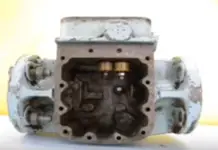Insulators:
Insulators are the elements which provide the insulation between the two different voltages levels. i.e insulation between the line conductors and other metallic structure. Insulators are playing major roles in electrical power system. In overhead transmission lines the conductor will be supported with the help of insulators. The insulators protect the current flow between the conductor and earth point. Mostly glazed porcelain insulator and polymeric insulators are used.
Porcelain Insulator: Preferable for low voltage and high voltage.
Polymeric insulators: Only used to high voltage transmission line (HV and EHV)
[wp_ad_camp_1]
Property of Good Insulator:
- The insulator should bear the total conductor weight typically it should have high mechanical strength
- Zero leakage current flow. The insulator should offer high resistance for the leakage current.
- It should withstand over voltages such as transient over voltage, lightning voltage and other fault over voltages.
- It should be non-porous
- High di-electric strength
- Hi puncture voltages to flash over voltage.
- It should not have any impurities like holes, cracks, etc
- High temperature withstand.
Types of insulators:
- Pin Insulator
- Suspension type insulators
- Strain insulators
- Shackle insulators
- Egg Insulators
[wp_ad_camp_4]
Pin Insulators:
A pin type insulator is designed to be mounted on a pin, which in turn is installed on cross-arm of the pole. The conductor passes in to a groove on the top of the insulator and soft aluminium binding wire according to the material of the conductor. The sufficient length of the leakage current path is obtained by providing insulator with 2 to 3 petticoats or rain sheds. The pin insulator is designed in disc shape to avoid leakage current during wet weather condition (raining). So that inside of the disc become dry for all the time. Pin insulator are Normally used up to 50 kV transmission line typically medium voltage transmission. Beyond operating voltage of 33 kV, the pin type insulators become too bulky and hence uneconomical. Replacement of pin insulators are very difficult. The insulators are its pin should be mechanically strong to with stand the conductor weight, Wind pressure, ice loading and other environmental aspect.
Suspension Type of insulators:
Suspension Types insulators are also called as string insulator or disc insulators. As the pin insulators cannot be used if the voltage is more than 50kV. Hence the transmission voltage is more than 50 kV, the suspension type insulators are preferred. The cost of the suspension type insulators is very less as the voltage rating is high. They consist of porcelain disc and each disc is valued to withstand up to 11 kV. The number of voltage is depending on the voltage level of the transmission line. i.e if you are going to put suspension type insulator for 110 kV means, you should use at least 7 to 8 number of disc. Because the insulator will be fixed in the structure, hear The structure to conductor voltage will be 63.5kV. Therefore, we can put only 7 to 8 disc. Conductors are bound at the bottom of the insulator.
Advantages of suspension type insulators:
- More economical for the voltage above 33kV.
- Each replacement. i.e of one disc failured, means we do not want to replace the entire string.
- High mechanical strength
- The suspension type insulators are generally used with steel towers. As the conductors run below the earthed cross-arm of the tower, therefore, this arrangement provides partial protection from lightning.
[wp_ad_camp_3]
Strain Insulators:
Shackle insulators are nothing but a combination of two suspension type insulators. These insulators are used to take the tension of the conductors at terminations of the line and at angle positions of the line. Strain Insulators are preferred where the line is subjected to greater tension. In order to relieve the line of excessive tension. When the tension in lines is exceedingly high, where the distance between the tower is high, therefore single insulator carries the entire weight of the conductor, therefore two or more strings are used in parallel. You can see the diagram the disc insulators are used in vertical plane due to high line tension. Therefore, two number or more number strings are preferred to relieve the line tension. Example You can see them in electric railways power distribution.
Shackle Insulators:
Shackle insulators are quite interesting insulators; they can be fixed directly on the poles with the help of mounting bolts or to the cross arm. You can see them at our street 230 volts’ transmission system. The line conductor is fixed in the groove with a soft binding wire. They are preferred for indoor applications such as electrical panel board, small over transmission line etc.
Stay Insulators or Egg insulators:
The poles are supported with the help of stay wire. The stay insulator is used to hold the electrical pole with the stay wire refer the diagram. They are in egg shape, that’s why it’s called as egg insulators. They are preferred to avoid leakage current through the stay wire.









